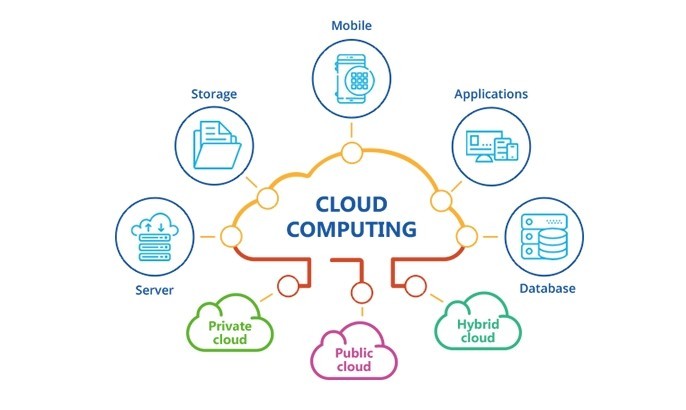
Did you know that CIO cloud computing entered its second wave back in 2017? To scale up infrastructure and improve efficiency while bringing down expenditure, enterprises have led the transformation that proved that cloud migration is a viable way to handle applications for big and medium businesses.
The success of enterprise cloud migration depends on the CIO's efforts and ability to impact their IT counterparts. However, a poorly planned migration plan can cause severe problems to the enterprise. Thus CIO's need to ask these crucial questions before launching the project.
1. Which strategy is suitable for cloud migration?
2. Which applications are suitable?
3. Do you have tools to help in migration?
4. What type of computing works best for what kinds of clouds?
Hybrid Clouds Offer Various Business-Driving Benefits
When looking for a SaaS migration strategy plan, you have two options: public or private cloud solutions. A while ago, enterprises used both a public cloud that runs off-premises and a private cloud that runs on-premises. But nowadays, a more complex hybrid has brought the transformation as it forms great alternatives to migration clouds. It has, therefore, has several benefits, which include:
1. Continued Employee Support from any Location
Many organizations have embraced the "work from anywhere" arrangements with their employees. They have therefore introduced cloud migration tools that will facilitate the success of such agreements.
With a hybrid cloud, you can be sure of flexibility which helps support the employees from anywhere with the required data. You can have a private server for sensitive information and a public server for other types of data.
2. Enhanced Security and Risk Management
The advantage of hybrid cloud computing is that it secures and controls private and public data. As an enterprise, you can choose which data you store in private servers based on the type of risk and the security it requires. Public data storage is prone to cyber-attacks and can expose the organization if they access critical information.
3. Minimizes Costs
Reduced costs are the key benefit of hybrid cloud computing for any organization that has embraced it. Hybrid cloud migration can reduce operations costs while offering strict data security.
It's expensive for companies that use only private data to store their data compared to those with combined storage (private and public) because of the advantage they get in future expansions to the public cloud, which is more affordable and offers less costly scaling.
4. Enhanced Data Control with Scalability
Hybrid cloud ensures that companies have control over their data when using private cloud migration.
While placing data on a public cloud is easy, organizations cannot entrust third parties with all their data. They, however, choose what to control and what to outsource to public cloud controllers.
5. Steady Business
Hybrid cloud is one of the migration models that offers your business decreased slowdown while improving reliability. If that is not enough, it further backs up critical data and allows data recovery in case of failure.
Always Plan for Scalability
To achieve scalability, you need to add more computing power sources to your existing infrastructure. You may include multiple cloud vendors, increased regions from a cloud vendor or more business-owned data centers. However, before deciding what to include, it's good to analyze your existing IT unit to see whether it can be upgraded or used more effectively.
In many enterprises, server utilization ranges from 5%- 15% and 30% of deployed data servers are turned on and never used and thus become effectively comatose. With the goal of planning scalability, revamping these servers by deploying agents who will add them to the cloud will be cost-effective compared to launching a whole new data cloud server.
The best and the easiest way to achieve scalability is by segmenting and distributing these jobs to different cloud providers using existing grid and scheduling engines while exercising a lot of care to ensure secure transfer to the processing centers.
Compliance and Security Matters
All data stored in cloud computing services must comply with existing security standards, especially the public cloud. One of the most recent data regulation requirements is the GDPR. It ensures that data is protected and the infrastructure is secure against possible attacks.
Although the law stipulates data security measures, you should also consider the organization standing on its security procedures and measures. Further, the CIO should confirm specific regulations related to your particular industry and have them put in place before adopting cloud migration.
Key Steps to Hybrid and Multi-Cloud Success

1. Prepare and Train your Organization
When introducing a new project in any organization, the first part is preparing and training the users to ensure its success. However, it can face rejection for fear of unknown change resistance. Prepare and change the mindset of the team that will be using hybrid multi-cloud. Ensure they understand that operating cloud terms will change when hosts and servers that were physical will no longer exist. Likewise, budgets will be opex and not the usual capex.
2. Assess Readiness
After preparation and training the users, assess their readiness before launching multi-cloud. Listen to their compliments and comments about the new changes and their concerns after the launch.
3. Simplify for Maturity
Use simplified procedures to ensure you achieve maturity within the shortest time possible. With positive transformation and results, the users and the organization will fully embrace it and allow for the further complex procedure for managing data.
4. Develop a Forward-Looking Migration Strategy
When introducing multi-cloud to the organization, ensure you adopt a forward-looking migration strategy to keep the users anxious about the next steps and results. Teams feel motivated when launching projects which have well-established strategies ahead.
5. Develop an Enterprise Cloud Management Strategy
Cloud management strategies that you adopt should be straightforward and specific for your organization. Ensure it's a strategy that suits the type of data you handle and how you want it handled from different locations.
6. Untangle Applications
Untangle all applications and arrange them to fit the new enterprise multi-cloud. Test, learn and adapt your approach on migration experience by experimenting with non-essential workloads and tests. Use the untangling opportunity to upskill your IT staff who will handle the migration path while solving complexities. It will however be cheaper than employing new staff who have experience in the field.
7. Don't forget Management
While working on these changes, their success lies in the participation and authorization of the management because you require critical information revelation, held by the management only. Therefore management involvement is vital for the smooth launching and success of multi-cloud.
8. Adopt New Ways of Working
While every organization has an existing IT system they work with, the introduction of multi-cloud automatically introduces new working methods. Thus teams can work from anywhere and deliver the expected results without stepping into the office.
Conclusion
When talking of business transformation, you can't fail to mention enterprise cloud migration, which is the recent revelation that you can achieve results without overclouding in the office. However, a lot of effort, dedication and co-operation from management and the users is critical in ensuring the success of this new platform that allows people to work from anywhere.
You can't ask for more!





